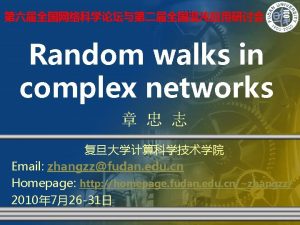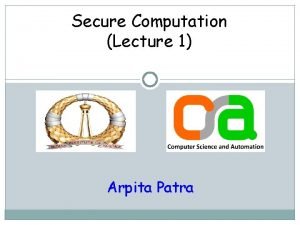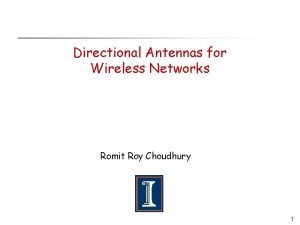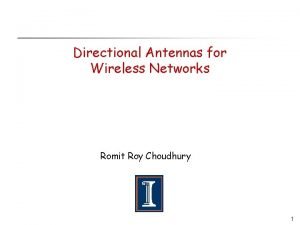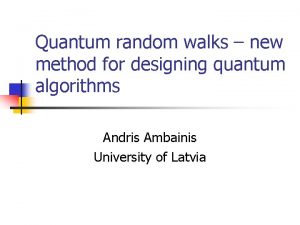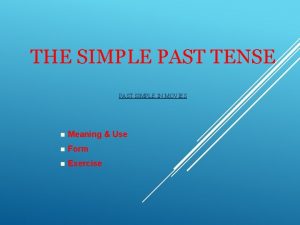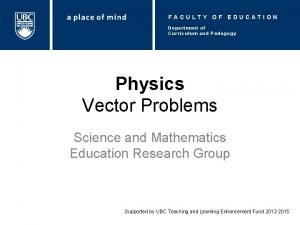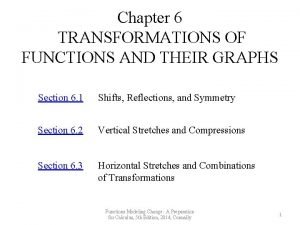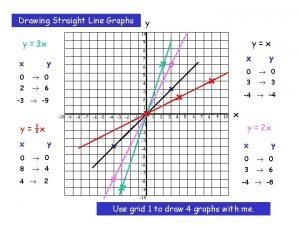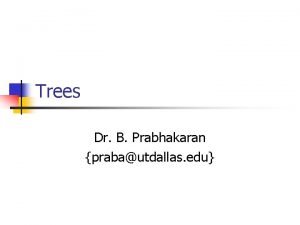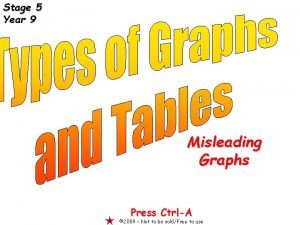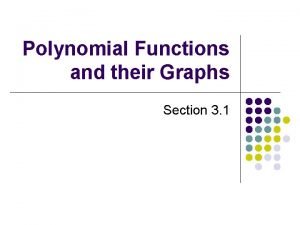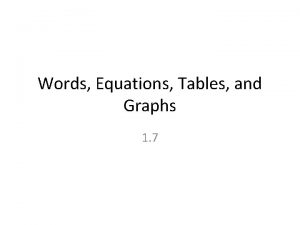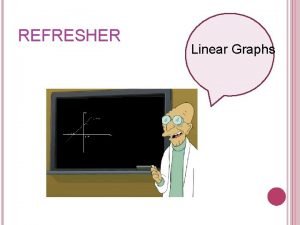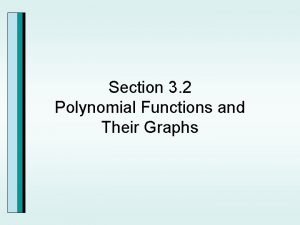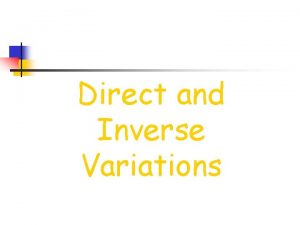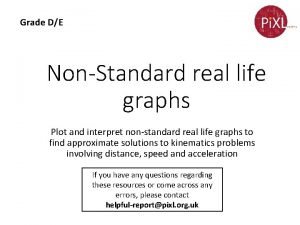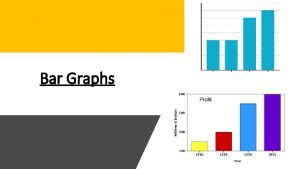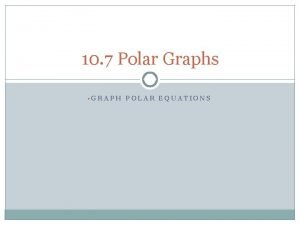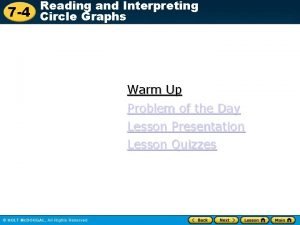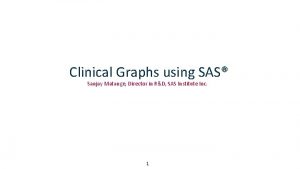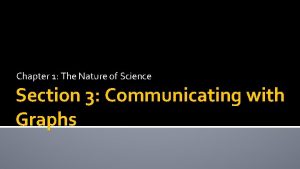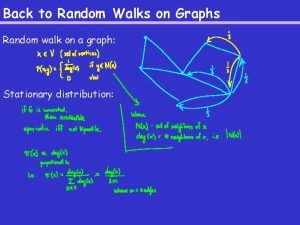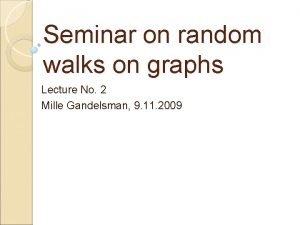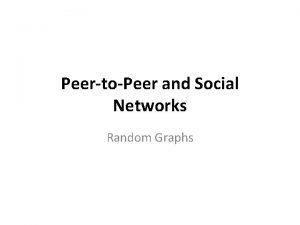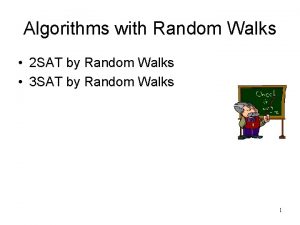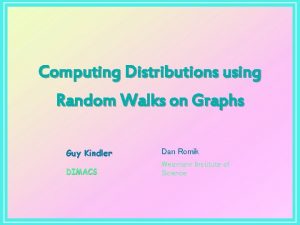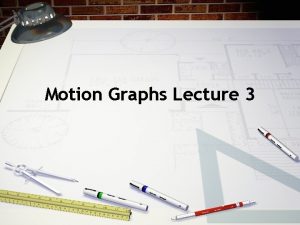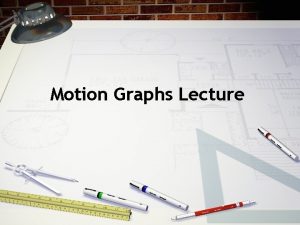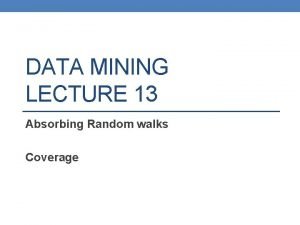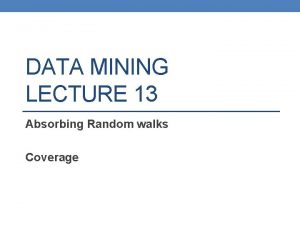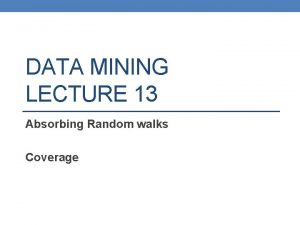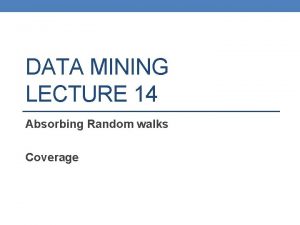Lecture 18 Random Walks on Graphs Monojit Choudhury












![Revisiting time-reversibility • P*[i]M[i][j] = P*[j]M[j][i] • However, P*[i]M[i][j] = 1/(2 m) – We Revisiting time-reversibility • P*[i]M[i][j] = P*[j]M[j][i] • However, P*[i]M[i][j] = 1/(2 m) – We](https://slidetodoc.com/presentation_image_h2/dfc2088671dd5939c552019dde33f55f/image-13.jpg)












![The Markov Chain • Recursive dependency: a(v) Σ h(w) w Є pa[v] h(v) Σ The Markov Chain • Recursive dependency: a(v) Σ h(w) w Є pa[v] h(v) Σ](https://slidetodoc.com/presentation_image_h2/dfc2088671dd5939c552019dde33f55f/image-26.jpg)
































- Slides: 58

Lecture 18 Random Walks on Graphs Monojit Choudhury monojitc@microsoft. com

What is a Random Walk • Given a graph and a starting point (node), we select a neighbor of it at random, and move to this neighbor; • Then we select a neighbor of this node and move to it, and so on; • The (random) sequence of nodes selected this way is a random walk on the graph

An example Transition matrix P Adjacency matrix A B 1 1 A 1 C 1 1/2 Slide from Purnamitra Sarkar, Random Walks on Graphs: An Overview 3

An example 1 t=0, A B 1/2 1 A 1/2 C Slide from Purnamitra Sarkar, Random Walks on Graphs: An Overview 4

An example 1 B 1/2 1 A 1/2 t=1, AB t=0, A C 1 1 1/2 Slide from Purnamitra Sarkar, Random Walks on Graphs: An Overview 5

An example B 1 1/2 1 A 1/2 t=1, AB t=0, A 1 1 1/2 C t=2, ABC 1 1 1/2 Slide from Purnamitra Sarkar, Random Walks on Graphs: An Overview 6

An example B 1 1/2 1 A 1/2 t=1, AB t=0, A 1 1/2 C t=2, ABC 1 1 1/2 t=3, ABCA ABCB 1 1 1/2 1/2 Slide from Purnamitra Sarkar, Random Walks on Graphs: An Overview 7

Why are random walks interesting? • When the underlying data has a natural graph structure, several physical processes can be conceived as a random walk Data WWW Internet P 2 P Social network Process Random surfer Routing Search Information percolation

More examples • Classic ones – Brownian motion – Electrical circuits (resistances) – Lattices and Ising models • Not so obvious ones – Shuffling and permutations – Music – Language

Random Walks & Markov Chains • A random walk on a directed graph is nothing but a Markov chain! • Initial node: chosen from a distribution P 0 • Transition matrix: M= D-1 A – When does M exist? – When is M symmetric? • Random Walk: Pt+1 = MTPt – Pt = (MT)t. P 0

Properties of Markov Chains • Symmetric: P(u v) = P(v u) – Any random walk (v 0, …, vt), when reversed, has the same probability if v 0= vt • Time Reversibility: The reversed walk is also a random walk with initial distribution as Pt • Stationary or Steady-state: P* is stationary if P* = MTP*

More on stationary distribution • For every graph G, the following is stationary distribution: P*(v) = d(v)/2 m – For which type of graph, the uniform distribution is stationary? • Stationary distribution is unique, when … • t , Pt P*; but not when …
![Revisiting timereversibility PiMij PjMji However PiMij 12 m We Revisiting time-reversibility • P*[i]M[i][j] = P*[j]M[j][i] • However, P*[i]M[i][j] = 1/(2 m) – We](https://slidetodoc.com/presentation_image_h2/dfc2088671dd5939c552019dde33f55f/image-13.jpg)
Revisiting time-reversibility • P*[i]M[i][j] = P*[j]M[j][i] • However, P*[i]M[i][j] = 1/(2 m) – We move along every edge, along every given direction with the same frequency – What is the expected number of steps before revisiting an edge? – What is the expected number of steps before revisiting a node?

Important parameters of random walk • Access time or hitting time Hij is the expected number of steps before node j is visited, starting from node i • Commute time: i j i: Hij + Hji • Cover time: Starting from a node/distribution the expected number of steps to reach every node

Problems • Compute access time for any pair of nodes for Kn • Can you express the cover time of a path by access time? • For which kind of graphs, cover time is infinity? • What can you infer about a graph which a large number of nodes but very low cover time?

Lecture 19 Applications of Random Walks on Graphs Monojit Choudhury monojitc@microsoft. com

Ranking Webpages • The problem statement: – Given a query word, – Given a large number of webpages consisting of the query word – Based on the hyperlink structure, find out which of the webpages are most relevant to the query • Similar problems: – Citation networks, Recommender systems

Mixing rate • How fast the random walk converges to its limiting distribution • Very important for analysis/usability of algorithms • Mixing rates for some graphs can be very small: O(log n)

Mixing Rate and Spectral Gap • Spectral gap: 1 - 2 • It can be shown that • Smaller the value of 2 larger is the spectral gap, faster is the mixing rate

Recap: Pagerank • Simulate a random surfer by the power iteration method • Problems – Not unique if the graph is disconnected – 0 pagerank if there are no incoming links or if there are sinks – Computationally intensive? – Stability & Cost of recomputation (web is dynamic) – Does not take into account the specific query – Easy to fool

Page. Rank • The surfer jumps to an arbitrary page with non -zero probability (escape probability) M’ = (1 -w)M + w. E • This solves: – Sink problem – Disconnectedness – Converges fast if w is chosen appropriately – Stability and need for recomputation • But still ignores the query word

HITS • Hypertext Induced Topic Selection – By Jon Kleinberg, 1998 • For each vertex v Є V in a subgraph of interest: – a(v) - the authority of v – h(v) - the hubness of v • A site is very authoritative if it receives many citations. Citation from important sites weight more than citations from less-important sites • Hubness shows the importance of a site. A good hub is a site that links to many authoritative sites

HITS: Constructing the Query graph


Authorities and Hubs 5 2 3 1 1 4 6 7 a(1) = h(2) + h(3) + h(4) h(1) = a(5) + a(6) + a(7)
![The Markov Chain Recursive dependency av Σ hw w Є pav hv Σ The Markov Chain • Recursive dependency: a(v) Σ h(w) w Є pa[v] h(v) Σ](https://slidetodoc.com/presentation_image_h2/dfc2088671dd5939c552019dde33f55f/image-26.jpg)
The Markov Chain • Recursive dependency: a(v) Σ h(w) w Є pa[v] h(v) Σ a(w) w Є ch[v] Can you prove that it will converge?

HITS: Example Authority Hubness 1 2 3 4 5 6 7 8 9 10 11 12 13 14 15 Authority and hubness weights

Limitations of HITS • • Sink problem: Solved Disconnectedness: an issue Convergence: Not a problem Stability: Quite robust • You can still fool HITS easily! – Tightly Knit Community (TKC) Effect

Lecture 20 Applications Random Walks on Graphs - II Monojit Choudhury monojitc@microsoft. com

Acknowledgements • Some slides of these lectures are from: – Random Walks on Graphs: An Overview Purnamitra Sarkar – “Link Analysis Slides” from the book Modeling the Internet and the Web Pierre Baldi, Paolo Frasconi, Padhraic Smyth

References • Basics of Random Walk: – L. Lovasz (1993) Random Walks on Graphs: A Survey • Page. Rank: – http: //en. wikipedia. org/wiki/Page. Rank – K. Bryan and T. Leise, The $25, 000 Eigenvector: The Linear Algebra Behind Google (www. rose-hulman. edu/~bryan) • HITS – J. M. Kleinberg (1999) Authorative Sources in a Hyperlinked Environment. Journal of the ACM 46 (5): 604– 632.

HITS on Citation Network • A = WTW is the co-citation matrix – What is A[i][j]? • H = WWT is the bibliographic coupling matrix – What is H[i][j]? • H. Small, Co-citation in the scientific literature: a new measure of the relationship between two documents, Journal of the American Society for Information Science 24 (1973) 265– 269. • M. M. Kessler, Bibliographic coupling between scientific papers, American Documentation 14 (1963) 10– 25.

SALSA: The Stochastic Approach for Link-Structure Analysis • Probabilistic extension of the HITS algorithm • Random walk is carried out by following hyperlinks both in the forward and in the backward direction • Two separate random walks – Hub walk – Authority walk • R. Lempel and S. Moran (2000) The stochastic approach for link-structure analysis (SALSA) and the TKC effect. Computer Networks 33 387 -401

The basic idea • Hub walk – Follow a Web link from a page uh to a page wa (a forward link) and then – Immediately traverse a backlink going from wa to vh, where (u, w) Є E and (v, w) Є E • Authority Walk – Follow a Web link from a page w(a) to a page u(h) (a backward link) and then – Immediately traverse a forward link going back from vh to wa where (u, w) Є E and (v, w) Є E


Analyzing SALSA

Analyzing SALSA Hub Matrix: = Authority Matrix: =

SALSA ranks are degrees!

Is it good? • It can be shown theoretically that SALSA does a better job than HITS in the presence of TKC effect • However, it also has its own limitations • Link Analysis: Which links (directed edges) in a network should be given more weight during the random walk? – An active area of research

Limits of Link Analysis (in IR) • META tags/ invisible text – Search engines relying on meta tags in documents are often misled (intentionally) by web developers • Pay-for-place – Search engine bias : organizations pay search engines and page rank – Advertisements: organizations pay high ranking pages for advertising space • With a primary effect of increased visibility to end users and a secondary effect of increased respectability due to relevance to high ranking page

Limits of Link Analysis (in IR) • Stability – Adding even a small number of nodes/edges to the graph has a significant impact • Topic drift – similar to TKC – A top authority may be a hub of pages on a different topic resulting in increased rank of the authority page • Content evolution – Adding/removing links/content can affect the intuitive authority rank of a page requiring recalculation of page ranks

Lecture 21 Applications Random Walks on Graphs - III Monojit Choudhury monojitc@microsoft. com

Clustering Using Random Walk

Chinese Whispers • C. Biemann (2006) Chinese whispers - an efficient graph clustering algorithm and its application to natural language processing problems. In Proc of HLT -NAACL’ 06 workshop on Text. Graphs, pages 73– 80 • Based on the game of “Chinese Whispers”

The Chinese Whispers Algorithm color sky weight 0. 9 0. 8 light -0. 5 0. 7 blue blood 0. 9 0. 5 red heavy

The Chinese Whispers Algorithm color sky weight 0. 9 0. 8 light -0. 5 0. 7 blue blood 0. 9 0. 5 red heavy

The Chinese Whispers Algorithm color sky weight 0. 9 0. 8 light -0. 5 0. 7 blue blood 0. 9 0. 5 red heavy

Properties • • • No parameters! Number of clusters? Does it converge for all graphs? How fast does it converge? What is the basis of clustering?

Affinity Propagation • B. J. Frey and D. Dueck (2007) Clustering by Passing Messages Between Data Points. Science 315, 972 • Choosing exemplars through real-valued message passing: – Responsibilities – Availabilities

Input • n points (nodes) • Similarity between them: s(i, k) – How suitable an exemplar k is for i. • s(k, k) = how likely it is for k to be an exemplar

Messages: Responsibility • Denoted by r(i, k) • Sent from i to k • The accumulated evidence for how well-suited point k is to serve as the exemplar for point i, taking into account other potential exemplars

Messages: Availability • Denoted by a(i, k) • Sent from k to i • The accumulated evidence for how appropriate it would be for point i to choose point k as its exemplar, taking into account the support from other points that point k should be an exemplar.


The Update Rules • Initialization: – a(i, k) = 0

Choosing Exemplars • After any iteration, choose that k as an exemplar for i for which a(i, k) + r(i, k) is maximum. • i is an exemplar itself if a(i, i) + r(i, i) is maximum.

An example

An example

An Example
 The man of integrity walks securely
The man of integrity walks securely Random walks
Random walks 5-3 polynomial functions
5-3 polynomial functions State testing and testability tips
State testing and testability tips Comparing distance/time graphs to speed/time graphs
Comparing distance/time graphs to speed/time graphs Graphs that enlighten and graphs that deceive
Graphs that enlighten and graphs that deceive 01:640:244 lecture notes - lecture 15: plat, idah, farad
01:640:244 lecture notes - lecture 15: plat, idah, farad Random assignment vs random sampling
Random assignment vs random sampling Random assignment vs random selection
Random assignment vs random selection Arpita choudhury age
Arpita choudhury age Romit roy choudhury
Romit roy choudhury Jahanara choudhury
Jahanara choudhury Fayezul choudhury
Fayezul choudhury Romit roy choudhury
Romit roy choudhury Nina roy choudhury
Nina roy choudhury Bepin choudhury lapse of memory objectives
Bepin choudhury lapse of memory objectives Rbar
Rbar Guard your hearts and minds
Guard your hearts and minds Character inferences
Character inferences What runs but never walks
What runs but never walks Gordon 101 poems
Gordon 101 poems She walks in beauty tone
She walks in beauty tone Walks in inverurie
Walks in inverurie Lord byron descendants
Lord byron descendants She walks in beauty quiz
She walks in beauty quiz Jazz walk
Jazz walk Manisha has secured 79 marks in the college
Manisha has secured 79 marks in the college Description of scout in chapter 1
Description of scout in chapter 1 Lord byron kimdir
Lord byron kimdir Maybe an old gingerbread man walks with one
Maybe an old gingerbread man walks with one Who walks the golden chain of lukomorye
Who walks the golden chain of lukomorye Lord byron she walks in beauty
Lord byron she walks in beauty Quantum walks
Quantum walks Who walks on padded paws
Who walks on padded paws When was the poem she walks in beauty written
When was the poem she walks in beauty written Quinton typically walks 28 yards south
Quinton typically walks 28 yards south Walks talent management
Walks talent management She walks in beauty imagery
She walks in beauty imagery Quantum walks
Quantum walks Past simple in movies
Past simple in movies Steve walks from point p to point q
Steve walks from point p to point q Had half impaired the nameless grace
Had half impaired the nameless grace He who walks with the wise grows wise
He who walks with the wise grows wise Vertical stretch vs compression
Vertical stretch vs compression Y=10 graph
Y=10 graph Which of the following graphs are trees
Which of the following graphs are trees Misleading graphs
Misleading graphs Types of polynomials
Types of polynomials Words equations tables and graphs
Words equations tables and graphs Interpreting linear graphs
Interpreting linear graphs Phantom graph
Phantom graph Polynomial functions and their graphs
Polynomial functions and their graphs What does a direct variation graph look like
What does a direct variation graph look like Real life graphs
Real life graphs Different kinds of graphs
Different kinds of graphs Jenis graph
Jenis graph Interpreting circle graphs
Interpreting circle graphs Sas swimmer plot
Sas swimmer plot The nature of science section 3 communicating with graphs
The nature of science section 3 communicating with graphs

